A sailboat for families with a serious need for speed
In 2009, my friend Don bought his new Multi 23 trimaran. I had heard of the French-designed and Chinese-built boats, a very light 600 lbs. driven by a fairly large sail plan, with the necessary reserve bouyancy in the amas to ride up on one hull. He had raced aboard his son's large carbon fiber catamaran, but was primarily a monohull sailboat guy before purchasing the Multi 23. Knowing that I had an interest in trimarans, he included me in his boating plans in an effort to pick up some multihull tips.
This is not quite the blind leading the blind, but maybe someone with cataracts leading the blind. I owned an F-27 and have sailed on various Corsair trimarans and other catamarans and trimarans. Sometimes an enthusiastic amateur is the best "expert" available, so I became Don's "expert" multihull guy!
The Multi 23 design is by Marc Van Peteghem & Vincent Lauriot-Prevost Yacht Design, creators of numerous racing and cruising multihull designs including Lagoon catamarans and the BWM Oracle America's Cup racing trimaran some call "DoGZilla." Their long history of popular, winning designs made me sure that the basic Multi 23 would be fast and fun, and would be engineered properly to meet the loads it will encounter.
Multi 23 Delivery & Setup
After months of anticipation, the day finally came when the new Multi 23 was to arrive, and I went down to the boat ramp to help with assembly of the boat. There I met Mike Leneman of Multimarine.com, who was delivering the boat. It did not look much like a boat at first, just a bunch of bubble-wrapped pieces on a trailer.
We cut away packing material, and started to mount the akas, or crossbeams. I got a look inside the hull and amas at that point, and was impressed with the quality of the layup. I could see no dry patches anywhere, nor any extra resin, no sloppy trimming of glass — basically none of the hallmarks of shoddy boat construction. The akas fit perfectly in their attachment points, and it started to look a little more like a boat.
Next came the process of mounting the amas and attaching the trampolines. This kind of activity with a new boat design is guaranteed to attract other multihull sailing enthusiasts, and that day was no exception. Leaning on the forward aka is former Corsair dealer and Charlotte County area realtor Jim Mulligan, who came by to see the new boat with his partner John, a former Corsair sailor who now owns a Stiletto. Yes, we were all supposed to be working, but no multihull sailor can resist going to check out a new boat and talk about it with other sailors!
With the amas and akas installed and the trampolines stretched tight, it was time to raise the mast. The rotating foil shaped mast on this boat is aluminum, with carbon fiber spreaders. It is pre-tensioned with a double diamond rig, and rests on a ball that is mounted on the forward aka. To raise it, we used the boom as a gin pole and Mike's truck as a support stand. Check out the pre-bend in this mast!
Once the mast was up and the jib furler attached to the bow, it was time to tension the cap shrouds, which just have a multi-part section of that crazy high tech line, Dyneema or something, as tensioner tackle. Unlike the cap shrouds on our old Corsair F-27 trimaran, these do not appear to be intended for adjustment while under sail. With the rig tensioned, the Multi 23 was ready for launch.
I put together a short video showing the process of assembling and rigging the Multi 23:
https://youtube.com/watch?v=UD_YHeoZ__Q%26hl%3Den_US%26fs%3D1%26
My first time out sailing it, there were three of us aboard, and the wind almost completely died on us. The Multi 23 was able to sail along slowly despite the heavy crew load and lack of wind, but it was more frustrating than fun. We only had the standard main and blade jib at that time, so we could not even catch what little air there was with a large headsail. After a while, we got tired of bobbing around slowly and went home. I did not even take any pictures that day.
I got a call early this week asking whether I would be interested in sailing in a race with the Charlotte Harbor Multihull Association on Thursday. Yes, more than a little interested! I showed up at the boat a little early, and no one was around. The boat sat at the dock, stripped of sails and unprepared to race

I figured they would be along soon, and took the time to apply some sunscreen. After a while, when no one showed up, I began to wonder whether we could make the start line in time if they did not show up soon. I called the owner of the boat, who was blissfully having a late breakfast at IHOP, having forgotten about our race schedule. He came home in a hurry, and we threw the sails and gear on the boat and headed out. Our third crew member could not make it, which was just as well since the wind was pretty light. We put up the reacher to make sure all the lines were run clear and untangled on our way out.

The CHMA is a pretty informal group, meeting at a local restaurant and using government marks and keeping their own race times with GPS. They use no committee boat, and only one starting line mark. There are a variety of boats, including cruising catamarans, homebuilt trimarans, Corsairs and a few racing oriented boats like the Multi 23. It's kind of the opposite of serious class racing, but a very good time! It is fun to head out on the harbor and start to see multihull sailboats converging from every direction.

Among the boats that came out to sail that day were a big cruising catamaran, a Corsair Sprint 750 named "Improbable," along with a Stiletto 27 catamaran and what appeared to be a homebuilt trimaran:

The winds were light, and the course for the day was from Charlotte Harbor marker 2 down to marker 1, over to marker 7 in the mouth of the Myakka River, then return to the start/finish line at marker 2. With the wind from the Northeast, our initial course was almost directly downwind. We got off to a good start and right away we were out in front of the fleet. A couple of the boats decided to go wing on wing, straight for the mark. The Stiletto was trying without success to use his jib as well, making for a weird looking cutter rigged multihull trying to go straight downwind

Not to be outdone with unconventional sailing tactics, we quickly invented and deployed the footerhauler, a specialized sailing device used to help hold the proper shape in a Multi 23's reacher.

We turned away from the mark a bit and tried sailing a hotter angle. We were going faster than the other boats, but not quite going in the right direction. In the end, as often happens with multihulls, the hotter angles proved faster. We were also helped by a favorable wind shift and increase in wind speed near the mark, but it seemed to me that our speed more than made up for the extra distance covered, even if we had not gotten the lucky shift. By the time we rounded marker 1, the Stiletto and the Corsair were well behind us, still moving slowly downwind, while we took off on the reaching leg at more than twice their speed. Though I should have been concentrating on our speed and maintaining course toward the mark, I could not resist snapping a picture of our competitors back at the mark.

I also took a moment to preserve the moment on video, which I shot using my waterproof Canon Powershot D10. The D10 is a great little waterproof camera but does not have the video quality of modern camcorders. At least I don't mind taking it out on wet boats like my Hobie Adventure Island!
https://youtube.com/watch?v=-YVSWpSwYP4%26hl%3Den_US%26fs%3D1%26

Reaching across to marker 7, I was experiencing some feedback on the tiller, but did not think anything of it. After a minute or so, the owner realized we were still cruising along with the centerboard mostly retracted. He pulled it down and immediately the helm was pleasantly neutral, but I could feel and hear the board moving around down there, along with tremendous turbulence in the trunk. At the speed we were going, it seemed to me that the reduced drag from neutralizing the helm was offset by the increased drag from the now-fully-open centerboard trunk. I am told that Mike at Multimarine.com has devised a fairing that drops into place as the board is extended, which should reduce this source of drag quite a bit. The owner of the boat told me that when boat speed reaches around 15 knots, the center hull will lift out of the water and the boat rides along on one low-drag ama. The acceleration when the vaka lifts is exciting, but we did not have the necessary wind to have that kind of fun.
Rounding marker 7, the wind died down quite a bit. We dropped the reacher and rolled out the blade jib, and slowed down so much that I was wondering whether the boat had the stored energy necessary to tack. It did, barely. We adjusted the travelers, sheeted and shaped the sails, and headed off on a long tack across the harbor.
Steering the boat upwind was a bit of a challenge for me. I was sitting as far forward as possible, and there was just not that much boat out in front of me to watch. Many of the telltales were stuck to the sails, and the yarns tied to the cap shrouds were above and behind me. I could not really tell which way I was pointing the boat, which way the wind was currently coming from, nor whether the telltales on either side of the sails were fluttering. I managed to figure out what the boat would do upwind, and was pretty impressed with our tacking angles.
While we were trying to get going upwind, the Corsair Sprint 750 made up a lot of ground on us. I'm not sure what happened to the Stiletto, which I figured would be pretty fast on the reaching leg, but by the time we got to marker 7 they were far behind. The Sprint rounded the mark and started coming upwind pretty fast, but not as close to the wind as we were sailing. The extra speed did not help them, and they were unable to close the distance between us on that leg. We finished with line honors, and probably beat the fleet on corrected time, but one of the nice things about the Charlotte Harbor Multihull Club races is that no one really cares who won on corrected time, including me! I'm just glad to work on our skills so we can make a decent showing in some of the more serious races on the harbor, and it's always fun to see friends sailing multihulls on the harbor.
After the race was over, we sailed around a bit and encountered Catboat Willy out sailing his Marshall catboat before returning to the dock in Punta Gorda Isles.

Our next time out was quite a bit more exciting. Racing on Feb 28, 2010 with the Punta Gorda Sailing Club, we left the dock around noon, with winds in the low teens and just a few whitecaps starting to appear. Heading out into the harbor, we saw a Sea Pearl with tanbark sails going by at a good clip.
By race time, the wind was a steady 15 with gusts to 20 and the typical nasty harbor chop with whitecaps everywhere. Only one Stiletto showed up to compete in the multihull class, and we got a good start while they wound up in irons on the line. Somehow, they recovered from that error and got out ahead of us, forcing us to duck out in mid course at one point. They had to make an extra tack and we were ahead again rounding the upwind mark, then we took off downwind and left them behind, eating up the whole fleet of hull-impaired boats on a wide jibe at speeds up to 13 knots. We were just flying the leisure main and jib and did not use the screacher, as neither of us is really ready to handle that sail in those winds.
The second lap went smoothly, as we are starting to learn the little things that make life easier when tacking and rounding the marks. The blast downwind was not as fast because the wind eased up a bit, and if we had had more race course in front of us when it happened, we would have benefitted from launching the screacher, but decided we were better off concentrating on getting the speed we could with the sails we had in the short distance remaining. We were a little early calling the jibe down to the finish line and wound up going too deep and too slow for a little bit, but still finished the 4 mile course in about 45 minutes. I wanted to take pictures and video while we were zipping along, but now realize that will only be possible when we have another crewman on board.

Update 3/29/10: We sailed in the 2010 Leukemia Cup Regatta in Charlotte Harbor, and did OK. I took a few nice pictures and some video.
https://youtube.com/watch?v=Mp4RCieIv-Y%26hl%3Den_US%26fs%3D1%26
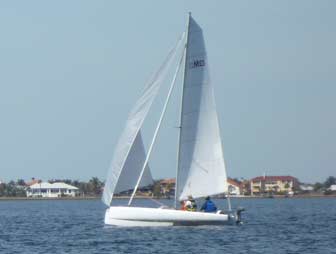
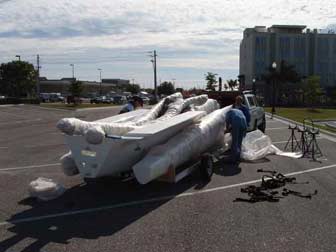
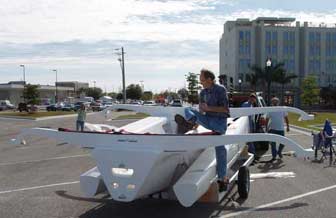
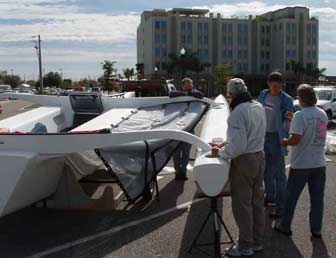
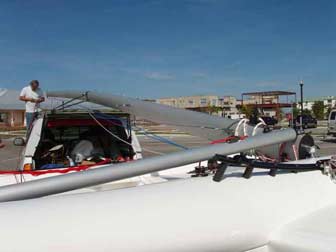
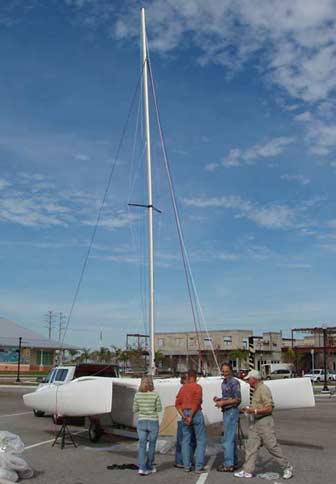
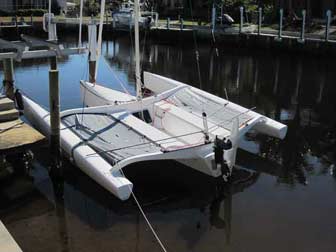
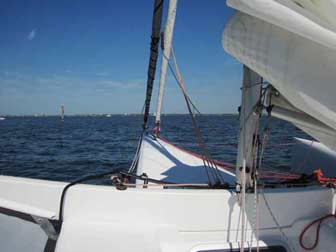
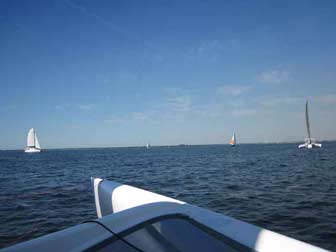
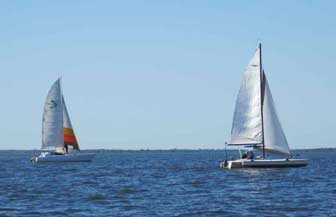
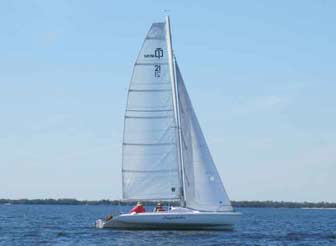
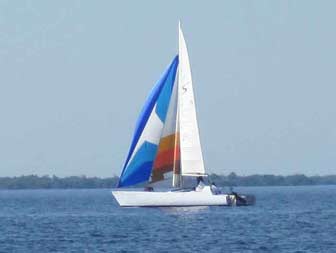
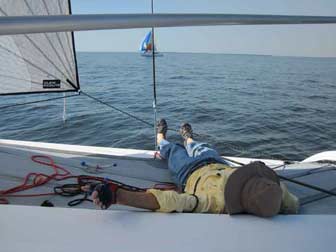
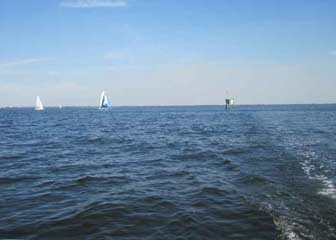
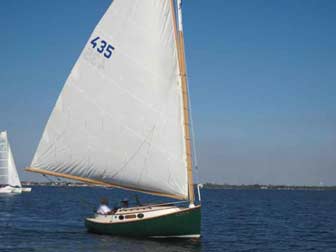
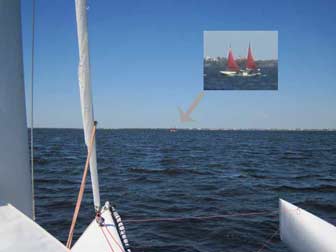
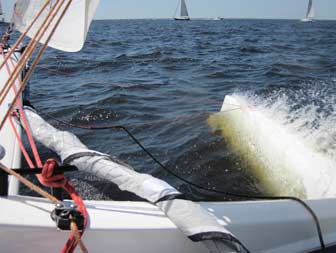
Leave a Reply
You must be logged in to post a comment.